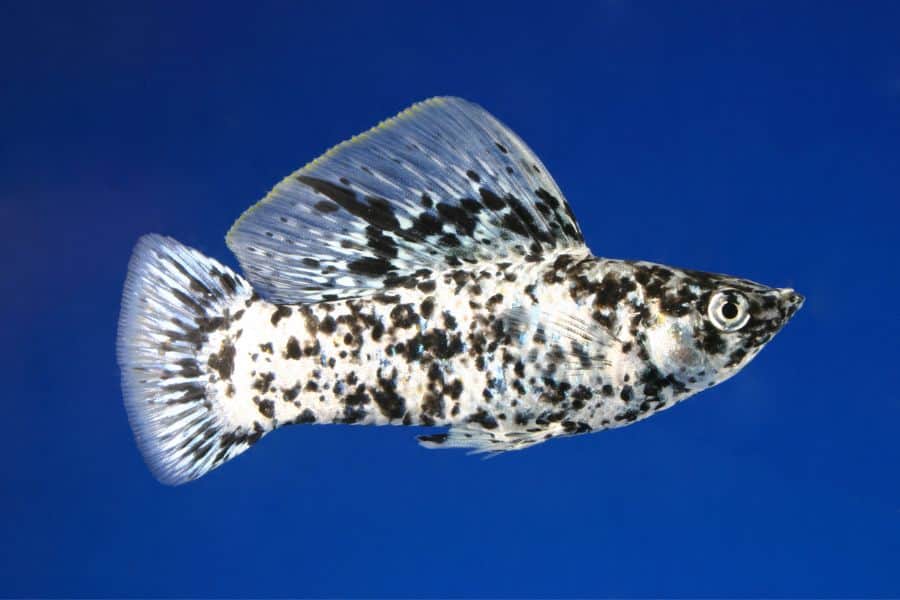The Dalmatian Molly is well-known public shared tank species. These energetic fish enjoys swimming in clusters, making them the center of attraction in a freshwater tank.
This species, which may be located in the somewhat shallow seas of California and Antigua, has been domesticated by aquatic enthusiasts all over the globe.
Get your dalmatian molly some aquatic friends! They are very friendly animals; therefore, if you don’t expose them to their fellow aquarium companions, they might start to feel depressed and anxious.
Let’s find out more details about this species and how you can take care of them in your home tank.
Dalmatian Molly Overview
- Scientific name: Poecilia latipinna
- Size: 3–5 inches
- Life expectancy: 3–5 years
- Primary color: White body with black spots
- Diet: Omnivore
- Nature: Peaceful
- Minimum tank size: 30 gallons
- Tank temperature: 70–82°F (21–27°C)
- Water pH: 7.0–7.8
- Water hardness: 12–25 dGH
- Care level: Easy
- Breeding: Livebearer
The dalmatian molly is a variety of freshwater fish that is classified under the Poeciliidae group. It is among the top-notch freshwater species that are most likely encountered in the fishery sector and is available in several fish pet shops all over the globe.
The dalmatian molly has been initially found in the southeastern United States. In the natural environment, these species live in tropical and continental aquatic reservoirs, wetlands, seas, and streams.
This fish is being domesticated by enthusiasts all over the globe in their home tanks. It is located in very brackish areas of California and Antigua.
Dalmatian mollies don’t care where they reside. The freshwater aquariums must consist of areas where they can hide out when it’s their mealtime or if they get scared.
Appearance
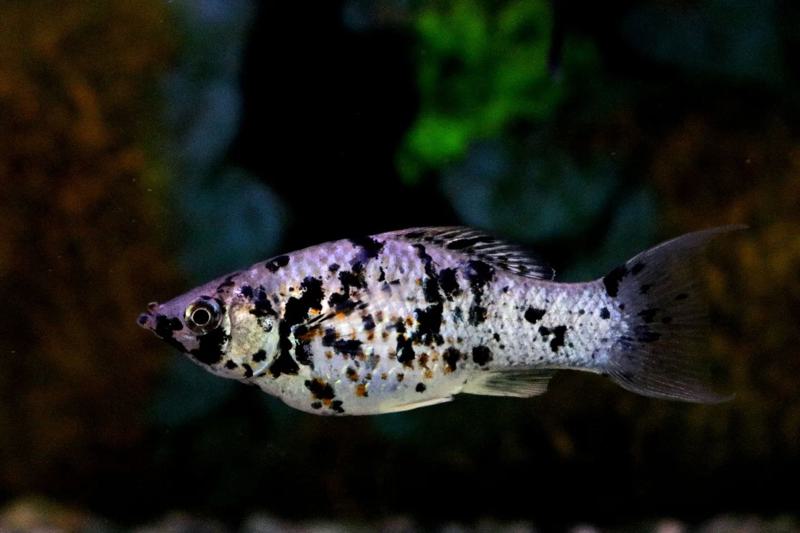
The dalmatian molly’s main distinguishing trait is its color, which resembles the fur of a dalmatian canine. The dalmatian molly grows to be around 3-5 inches in length during their adulthood, with males being shorter than females.
Due to their endurance and flexibility in maintenance, these species are well-liked freshwater animals. If this animal was being properly looked after in similar habitats, it would effortlessly adjust to new ones.
This species obtains its title from the unique black-and-white marking on its belly and tail. Although the fish’s color might change, it is often black and white.
The frontal fin features straight lines that switch between black and white patterns. Despite often being shorter than the frontal fin, the perineal fin possesses an identical appearance.
The ventral fin might even vary in shades based on the animal breed. Male dalmatian mollies exhibit more vibrant tones than female mollies.
Fin length is another potential difference between males and females, although this is not necessarily true in every case. Despite the fact that males tend to be shorter than females, males that have not yet attained reproductive maturation could look the same as females.
Temperament
Although Dalmatian mollies are usually calm, they have the potential to turn violent if they sense danger from some other species or from abnormalities in their surroundings.
In order to avoid them getting aggressive, it is recommended to have a minimum of two mollies in each aquarium. They generally prefer their personal space. It is essential to maintain them away from other freshwater species since these fish might get hostile to them.
They are mainly responsible for biting other species’ gills and tails, particularly the ones that look tiny to them. They may live in the same aquarium as non-aggressive fish such as tetras, barbs, or guppies.
These species are fast swimmers and love having lots of space to investigate their environment in a freshwater tank. Being quite outgoing and energetic throughout the day, these fish like to stick to the surface or middle level of the aquarium.
Life Expectancy
These species have a 3-5 yeas of lifespan when kept in aquariums. But, in the right circumstances—with balanced nutrition and high-quality water—some fish may last as much as ten years.
Dalmatian Molly Care
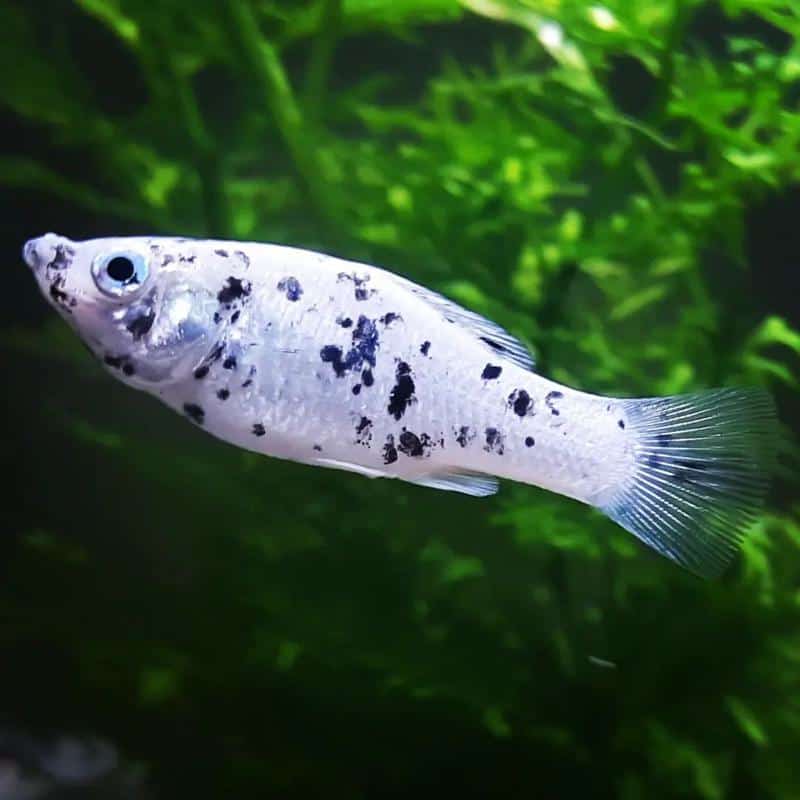
Although dalmatian species are generally easy to care for, they need some essential maintenance. In order to maintain the freshwater in the aquarium pure and chlorinated, you must include an aquatic filtration system as well as a water bubbler or other ventilation equipment.
Additionally, the aquarium must have amazing decor, hideaway spots, and vegetation. Dalmatian mollies enjoy fleshy items like larvae, crustaceans, red worms, and algal flakes. Fish should be fed at least twice a day.
Habitat
Dalmatian mollies are native to California and are often spotted in streams, coastlines, and lakes. They are exceptionally resilient species that do not demand special surroundings to grow.
They have a significant amount of plants and thrive in extremely clean saltwater in their natural surroundings. They are a fantastic option for both experienced and newbie fish keepers searching for a low-maintenance animal due to this reason.
It’s imperative to offer your pet enough oxygen through water that is kept around 74°F to 82°F (23°C to 28°C) in temperature to ensure their well-being and happiness. Your fish will definitely remain satisfied and fit if you provide it with a diversity of high-quality meals!
Tank Requirements
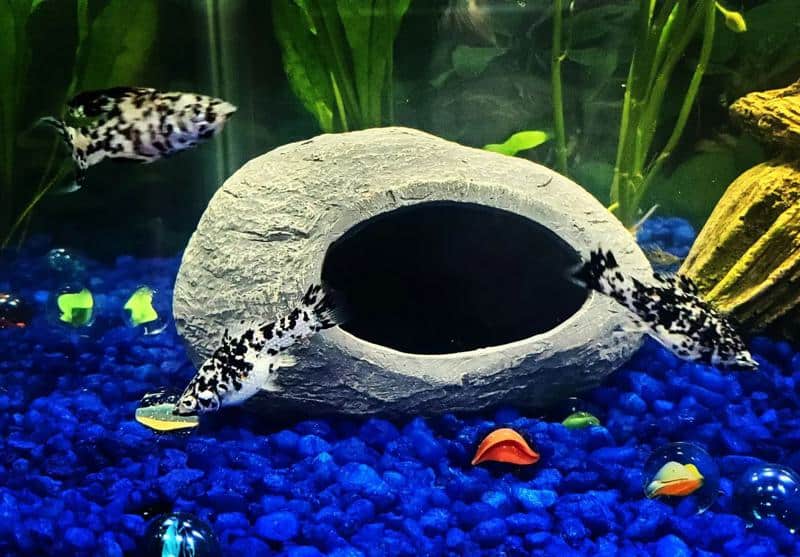
The Dalmatian molly lives on the southeastern California coast, so it requires tank water to be well-maintained ranging from 72 to 81 °F, and a pH level around 7.0-8.0.
They could barely withstand sudden thermal stress or adjustments in water composition; therefore, keep your aquarium clean to avoid significant instabilities and discomfort to your pet.
You’ll also require a steady water environment, a tank cleaner for bacterial purification, and co2 infusion for complete plant development.
Since mollies are opportunistic feeders, you’ll definitely require lots of excellent organic food, such as salad leaves or microalgae flakes, for them to munch on. The dalmatian molly will gladly devour saltwater shrimp larvae as a nutritional supplement, so don’t avoid offering them live snacks!
The Dalmatian Molly requires an aquarium with a minimum of 30 gallons capacity and a variety of hardy vegetation like Microsorum pteropus, Arrowhead, Eelgrass, and Anubias Nana.
Water Conditions
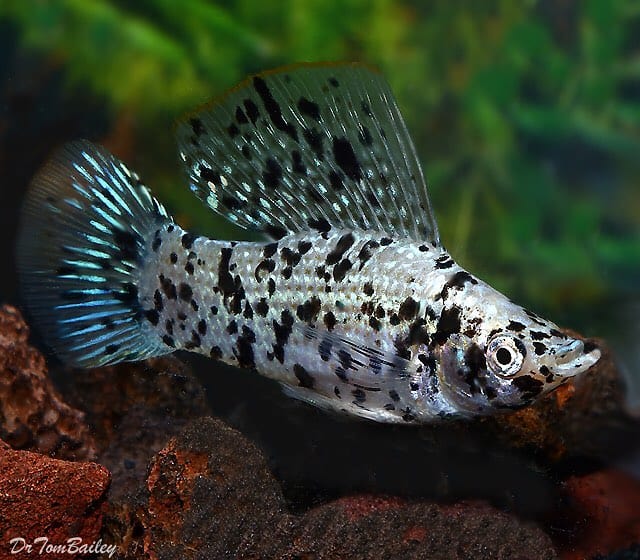
Dalmatian species, the same as other poeciliids, are vulnerable to lower levels of oxygen and get highly distressed. As a result, they need an aquarium with adequate water flow and strong ventilation.
Large amounts of vegetation are preferred over a decorative cave, even if these species do require some protection from strong water flows and other species that nibble at their delicate fins. Consider giving meals to a big group of dalmatian mollies multiple times daily because they can eat a lot of food.
Regular maintenance is essential for keeping your pet healthy, just like it is for any other animal. They need a container with a capacity of 30 gallons or more.
The ideal water temperature for mollies varies from 74 to 81 ℉. Include a reliable tank filtration system to assist keep the water fresh and the right amount of o2 and co2 in the habitat.
These species are powerful swimmers that could be dragged into electrical purifiers if not positioned ahead of a tank circulation or under-gravel water filtration system.
These small fellas are adorable, entertaining, and quite resilient, which ends up making them ideal beginner pets for people wishing to introduce a friendly species to their tank.
Tank Mates
Although Poecilia latipinna is a tiny fish, it moves extremely fast. It could serve as prey for predatory creatures and bigger cichlids. Sluggish aquarium companions would be followed inside the aquarium by the quick dalmatian molly with no way to escape.
Additionally, aquarium companions that stay on the substrate are not advised. They must be kept with tiny schooling species that aren’t particularly hostile in regards to their weight or intensity of aggression.
They are quite calm and may be housed in pairs. The following fish make suitable tank companions: tiny tetras, zebrafish, Pethia conchonius, dwarf gouramis, swordtail, chili rasboras, and guppies.
Interbreeding might occur if you house them with different mollies. They get along fine with other molly variants including Shortfin molly and Yucatan molly.
Aquatic crustaceans and snails are good aquarium companions for dalmatian species.
Breeding
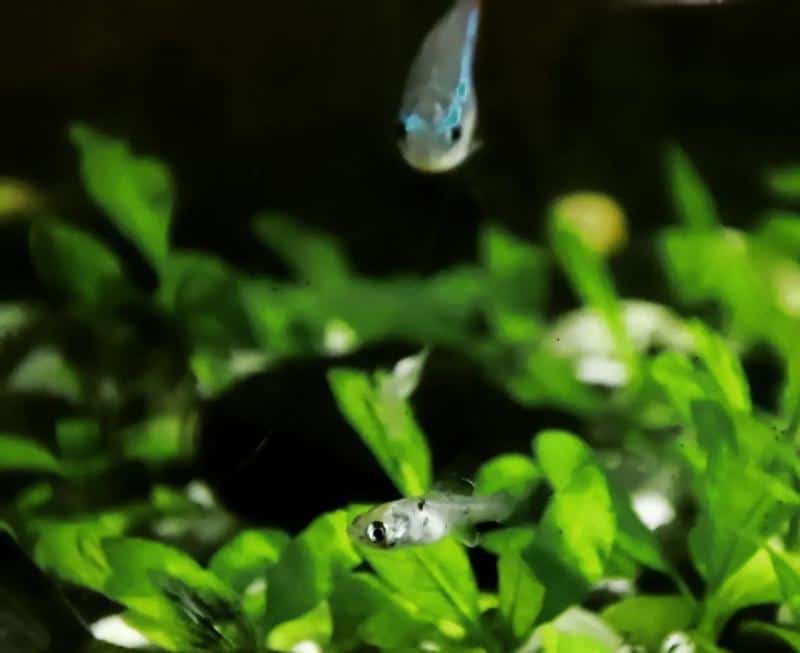
Among the species that are especially ideal for beginners to obtain include Dalmatian mollies. These species are livebearers and could be reproduced in a huge container as well as a reproductive chamber having a capacity of 20 gallons.
They do have a tendency to get very big, so a lake or tank that is the right size would be best for them. You may even buy baby mollies that other aquarium enthusiasts have successfully bred.
Since they have a high level of tolerance, these species can thrive in captivity. They will flourish if you give them enough room, nutrition, and pure water.
Dalmatian molly would lay her embryos in your home tank whenever it’s ready, often in the presence of sunlight.
Once the adult male Dalmatian has pollinated them, the mother will take care of them. The embryos would hatch after 48 hours as well as would be able to move around freely in 1-2 weeks.
In order to prevent any larvae from dying because of insufficient oxygen, it’s essential to eliminate any unwanted embryos from your tank because once they begin to emerge you can not control this situation. Your baby fish would be ready to consume algae shavings and worms after 3 weeks of age.
There are two methods for producing Dalmatian mollies: synthetic fertilization and live breeding. Live breeding demands a large aquarium, whereas synthetic fertilization calls for an egg bioreactor or fertilization container.
You would require the following supplies for each breeding technique:
- An aquarium having fresh water that has a minimum of 1-2 inches of depth.
- Airstone, also known as an oxygen-supplying air compressor (1 for every 10 gallons)
- Air pump-equipped filtration system
- Water softener
Dietary Needs
Dalmatian mollies are omnivores, which mean they consume both vegetation and meaty food. These species normally consume tiny bugs, invertebrates, larvae, microorganisms, and vegetation in their natural habitat.
To ensure that these species get a well-balanced meal, offer them a diverse range of delicacies in a domestic tank, such as frozen redworms, crustaceans, and freeze-dried wafers.
You may also give them premium fiber meals with microalgae seaweed or other dry meals made for tropical species.
Dalmatians must be served food only two times daily, in the daytime and at night. These species shouldn’t be fed excessively because doing so might cause diarrhea and inflammation as well as other health issues.
Parasites and Diseases
Dalmatian mollies are far more susceptible to parasite illnesses compared to the various species in your tank. You must regularly replace the contents in your pet’s housing container and arrange an isolation box for the remaining species.
The fact that they are usually housed in confined spaces means that there could be mold forming which may spread quickly in your tank. It’s a smart idea to step up right away if you detect anything strange concerning a particular fish.
If you notice any visible symptoms of sickness or illness, eliminate animals from your tank immediately. You should immediately transfer ill fish to an isolated aquarium where it would have lots of room and your other species would stay safe.
Predators
Fish and creatures with bigger size feed on dalmatian mollies. They suffer a significant death percentage because their offspring are consumed by other species, like guppies, once they go outside of their mother’s secured region.
It is believed that carnivores like to consume them due to their striking patterns, which could be detected from far away in shallow water. They become more convenient prey for attackers than those with faded patterns.
Related:
- Platy and Molly: Similarities and Differences
- Balloon Molly Fish: Appearance, Types & Care
- Molly Fish Types: Colors, Fin & Tail Variants
- Black Molly Fish
FAQs
Can You Keep Molly Fish in Saltwater Aquaria?
While mollies are normally supplied as freshwater species, they are developed to survive in saltwater. Using simple adapting techniques different molly species may readily move from freshwater to saltwater tanks.
A slower, more progressive flow technique could also be used to infuse them into full ocean saltwater installations (usually for a minimum of 3-4 hours.
How Many Dalmation Molly Fish Can Live in a 20-Gallon Tank?
You can just maintain 4 dalmatian mollies inside a 20-gallon aquarium.
How Many Male and Female Dalmatian Mollies Can You Keep Together in One Tank?
Keep no more than 1 male and 3 female molly species inside your aquarium if you do not wish to see it becoming a reproductive site. Since male dalmatian mollies are quite forceful during reproducing, you should maintain M: F molly proportion as 1:3.
Conclusion
Dalmatian mollies are excellent pets for any indoor tank, especially for amateurs. This fish is attractive, resilient, and simple to maintain.
These species are guaranteed to keep their owners entertained. When they’re not sneaking out behind stones and sculptures, these species like swimming about the aquarium at high speed. They are energetic and vibrant species.
These species don’t usually stay in schools. They like swimming by themselves or in tiny groups of 3 to 5 mollies.
They are cool-headed animals who don’t follow their aquarium companions everywhere or nip tails, unlike many other freshwater species.
